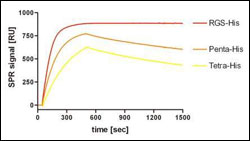Pair-wise Epitope mapping of monoclonal antibodies

The graph shows the binding of an RGS-His fusion protein to immobilised antibodies against a tetra-His, a penta-His and an RGS-His epitope. All antibodies recognize the epitope but only the anti-RGS-His antibody shows no dissociation when bound to the RGS-fusion protein after an association time of 450 seconds.
A complete characterization of monoclonal antibodies also includes the determination of epitope specificity for a given set of monoclonal antibodies. Epitope mapping is a powerful tool in analysing the surface topography of an antigen. The binding of an antibody to the antigen defines a specific binding site or epitope which sterically interferes with the binding of another antibody which has the same or a closely located binding site. The specificity of pairs of antibodies can easily be determined by testing the simultaneous binding to the antigen. Dinstinct binding sites can be identified by binding of both antibodies in parallel whereas an identical or closely located binding site prevents binding of the second antibody. BIA technology (Biomolecular Interaction Analysis) is ideally suited to automatically test panels of monoclonal antibodies and define their epitope specificity pattern.
Our antibody service “eitope mapping” includes the generation of working plans for the experimental setup, the performance of the epitope mapping analysis on a Biacore instrument and the complete evaluation of the results documented in a written report with figures. This report provides you with information about the epitope specificity pattern for your set of monoclonal antibodies i.e. which antibodies bind to the same epitope and which can bind simultaneously because they have different binding sites on the antigen. Please enquire for a detailed quote concerning your specific problem.
Media Contact
More Information:
http://www.biaffin.comAll latest news from the category: Life Sciences and Chemistry
Articles and reports from the Life Sciences and chemistry area deal with applied and basic research into modern biology, chemistry and human medicine.
Valuable information can be found on a range of life sciences fields including bacteriology, biochemistry, bionics, bioinformatics, biophysics, biotechnology, genetics, geobotany, human biology, marine biology, microbiology, molecular biology, cellular biology, zoology, bioinorganic chemistry, microchemistry and environmental chemistry.
Newest articles

A universal framework for spatial biology
SpatialData is a freely accessible tool to unify and integrate data from different omics technologies accounting for spatial information, which can provide holistic insights into health and disease. Biological processes…

How complex biological processes arise
A $20 million grant from the U.S. National Science Foundation (NSF) will support the establishment and operation of the National Synthesis Center for Emergence in the Molecular and Cellular Sciences (NCEMS) at…

Airborne single-photon lidar system achieves high-resolution 3D imaging
Compact, low-power system opens doors for photon-efficient drone and satellite-based environmental monitoring and mapping. Researchers have developed a compact and lightweight single-photon airborne lidar system that can acquire high-resolution 3D…





















